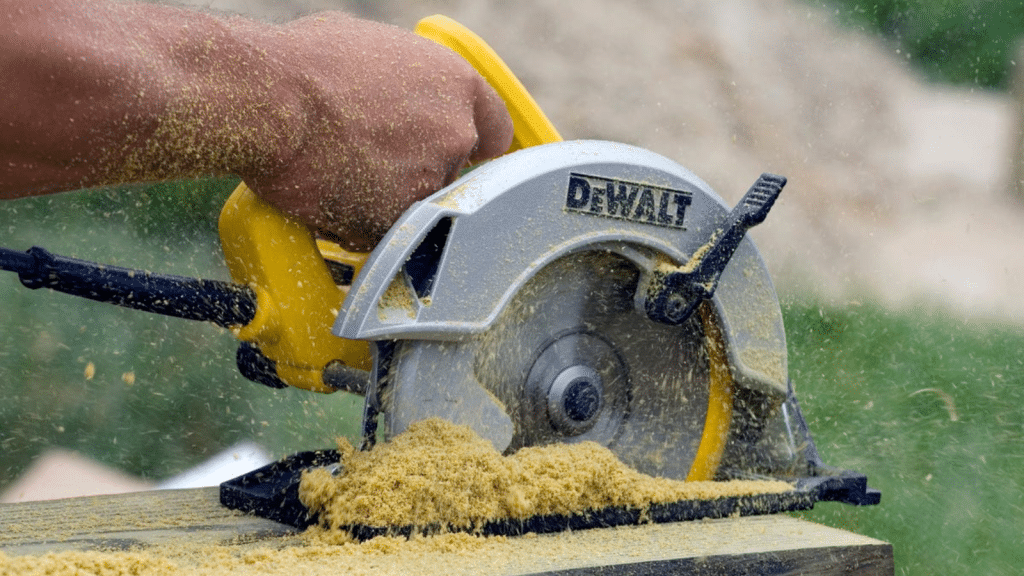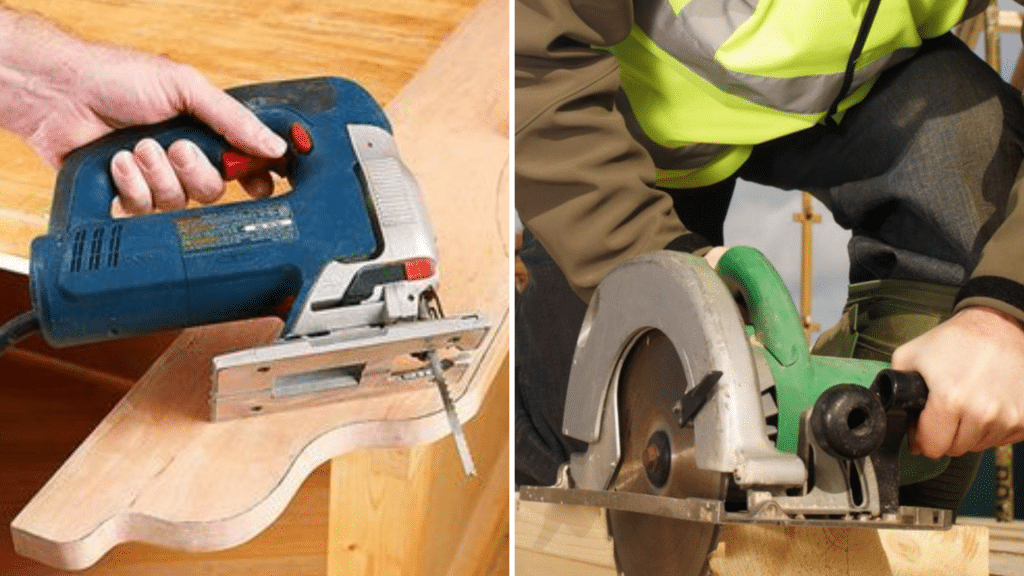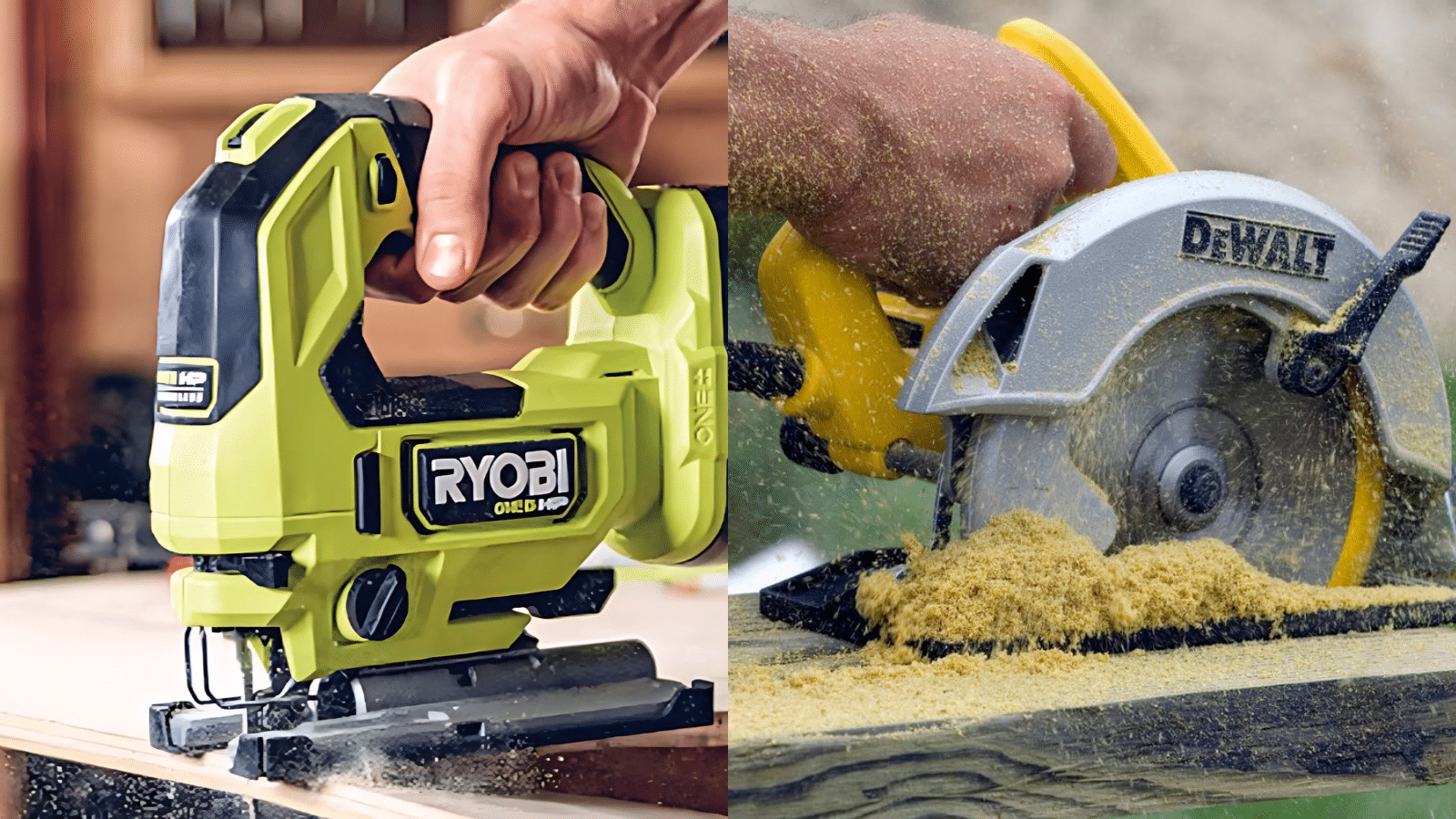Finding yourself uncertain about choosing between a jigsaw and a circular saw for your upcoming project? These two popular power tools serve different purposes, and choosing the right one can make your work easier and more efficient.
A jigsaw excels at cutting curves and intricate shapes with its up-and-down moving blade, while a circular saw’s spinning disc makes quick work of long, straight cuts through thick materials.
Each has its own strengths that make it suitable for specific types of projects.
Beginners and DIY enthusiasts must understand the key differences between these tools before purchasing. The right choice depends on your needs, the projects, and your experience level.
In this guide, we’ll compare jigsaws and circular saws across several important features to help you decide which one deserves a spot in your toolbox first. Let’s get started:
What is a Jigsaw?

A jigsaw is a small power tool used to cut different materials like wood, plastic, and metal. It has a thin, straight blade that moves up and down really fast.
This helps it make curved or detailed cuts that other saws can’t do easily. You hold it with one hand, and it’s easy to guide along lines or shapes you’ve drawn.
It’s a handy tool for small jobs, craft projects, or when you need to cut in tight spots.
Types of Jigsaw Blades
Jigsaw blades come in different shapes and sizes. Each type is made for cutting certain materials or making certain kinds of cuts. Here are the main types:
- T-Shank Blades: These are the most common today. They fit into most modern jigsaws without the need for tools to change them.
- U-Shank Blades: These have a U-shaped end. They are used in older jigsaws and may need a tool to switch out.
Jigsaw blades can also be different based on what they’re made to cut:
- Wood Blades – These have big teeth and cut fast.
- Metal Blades – These have small teeth and cut slowly but neatly.
- Plastic Blades – These are made to avoid cracking or melting the plastic.
- Special Blades – Some blades are made for tile, laminate, or other special jobs.
Always check the blade type before using it, so you don’t damage your material or your tool.
What is a Jigsaw Usually Used For?
A jigsaw is used when you need to make cuts that aren’t straight. It’s great for cutting curves, circles, and shapes in wood, metal, or plastic. People often use it for:
- Cutting out sinkholes in countertops
- Making craft shapes from wood
- Trimming flooring pieces to fit around corners
- Cutting thin metal sheets or plastic panels
- Small DIY jobs at home
Because the blade is narrow and easy to move, a jigsaw is perfect for careful, detailed cutting. It’s not the fastest saw, but it’s one of the most flexible.
Strengths & Weaknesses of a Jigsaw
Here is the in-depth table of strengths and weaknesses of Jigsaw:
| Strengths | Weaknesses |
|---|---|
| Great for cutting curves and shapes | Not good for long straight cuts |
| Easy to handle and control | Cuts can be slower |
| Works on wood, plastic, and metal | Blade can bend if pushed too hard |
| Lightweight and beginner-friendly | Not as powerful as other saws |
| Can start cuts from a drilled hole | Leaves a rougher edge on some materials |
What is a Circular Saw?

A circular saw is a power tool with a round blade that spins really fast. It’s used for cutting straight lines through wood, plastic, and even metal (with the right blade).
You hold it with two hands, and it cuts through materials quickly and cleanly.
The blade sticks out from the bottom of the saw, and you move it forward to cut. It’s strong, fast, and great for cutting big boards or long pieces of wood.
Types of Circular Saw Blades
Here are the top 7 types of circular saw blades:
- Crosscut Blade: For cutting across the grain of wood with smooth results.
- Rip Blade: Designed for cutting along the grain, with fewer teeth for faster cuts.
- Combination Blade: Versatile, works for both crosscuts and rip cuts.
- Finishing Blade: Offers ultra-smooth cuts, ideal for fine woodworking.
- Plywood Blade: Minimizes tear-out when cutting plywood or soft materials.
- Masonry Blade: Used for cutting through tough materials like concrete or stone.
- Metal Cutting Blade: Built for cutting metal with a durable, heat-resistant edge.
What is a Circular Saw Usually Used For?
A circular saw is used when you need to make straight, fast cuts. It’s great for cutting large pieces of wood, plywood, or boards. People often use it for:
- Cutting lumber for building projects
- Trimming large sheets of plywood
- Cutting down doors or panels to size
- Making straight cuts for fences, decks, and frames
- Cutting flooring planks
It’s a go-to tool for many building and home repair jobs because it’s strong and works quickly.
Strengths & Weaknesses of a Circular Saw
Here is the in-depth strength and strengths and weaknesses table:
| Strengths | Weaknesses |
|---|---|
| Cuts fast and straight | Hard to use for curves or small details |
| Works well on large boards and sheets | Heavier and louder than a jigsaw |
| Strong enough for tough materials | Needs more space to use safely |
| Good for building and framing jobs | Can be harder for beginners to handle |
| Many blade types for different jobs | Blade can kick back if not used carefully |
Jigsaw versus Circular Saw: What’s the Difference?

If you’re trying to decide between a jigsaw and a circular saw, it’s important to know what each tool does best. Both are useful, but they shine in different ways depending on the job.
Here’s a simple breakdown to help you compare them side by side:
1. Cutting Style
A jigsaw is made for cutting curves, corners, and special shapes. It’s great when you need to follow a line that bends or changes direction.
A circular saw is designed for long, straight cuts and works best when you’re slicing through boards or large panels in a straight line.
Better: Jigsaw for curves, Circular saw for straight lines
2. Blade Type
Jigsaws use a thin, straight blade that moves up and down. This makes it easier to turn the saw while cutting. Circular saws use a round spinning blade that moves fast and cuts smoothly in one straight line.
Better tool for it: Jigsaw for flexible cutting, Circular saw for clean, straight cuts
3. Ease of Use
Jigsaws are lighter and easier to control, especially for beginners. They’re also safer to use in tight spaces.
Circular saws are heavier and more powerful, which makes them a bit harder to handle, especially if you’re new to power tools.
Better tool for it: Jigsaw for beginners and small jobs
4. Speed and Power
Circular saws cut faster and can handle thicker or harder materials with ease. They’re built for heavy-duty work. Jigsaws are slower and better suited for lighter tasks or detailed cuts.
Better tool for it: Circular saw for speed and strength
5. Precision
If you need to cut out a shape, follow a curve, or work around corners, a jigsaw is a better tool. For long, smooth, straight cuts, a circular saw will give you better results.
Better tool for it: Jigsaw for shapes and detail, Circular saw for straight accuracy
Should I Buy a Circular Saw or a Jigsaw?
Choosing between a jigsaw and a circular saw depends on what kind of work you plan to do. Here’s a simple table to help you compare what each tool can handle:
| Task | Jigsaw | Circular Saw |
|---|---|---|
| Curved Cuts | ✓ | ✗ |
| Straight Cuts | ✗ | ✓ |
| Cutting Large Boards | ✗ | ✓ |
| Detail or Shape Work | ✓ | ✗ |
| Quick Cuts Through Thick Wood | ✗ | ✓ |
| Easy for Beginners | ✓ | ✗ |
| Cutting in Tight Spaces | ✓ | ✗ |
| Heavy-Duty Construction Work | ✗ | ✓ |
Bottom Line:
- Get a jigsaw if you mostly work on small projects, crafts, or need to cut curves and shapes. It’s easier to control and better for beginners. If you’re new to tools, a jigsaw is a safer choice to start with.
- Get a circular saw if you need to cut long, straight lines in thick wood or large boards. It’s stronger and faster but needs more care while using. If you’re building big stuff like shelves or fences, a circular saw might be better.
You can always get the second tool later when you need it.
Conclusion
Choosing between a jigsaw and a circular saw depends on the type of projects you plan to tackle most often. A jigsaw is ideal for crafts and detailed cuts. It’s lighter, more maneuverable, and beginner-friendly.
Its versatility makes it a smart first purchase for DIYers. For construction projects, straight cuts through lumber, or jobs requiring speed and power, a circular saw will serve you better.
While riskier to use, it excels at cutting larger materials efficiently. Many skilled woodworkers acquire both tools, as they complement each other well.
If your budget permits, choose a cutting style for your current projects and add a second tool as your skills improve.


